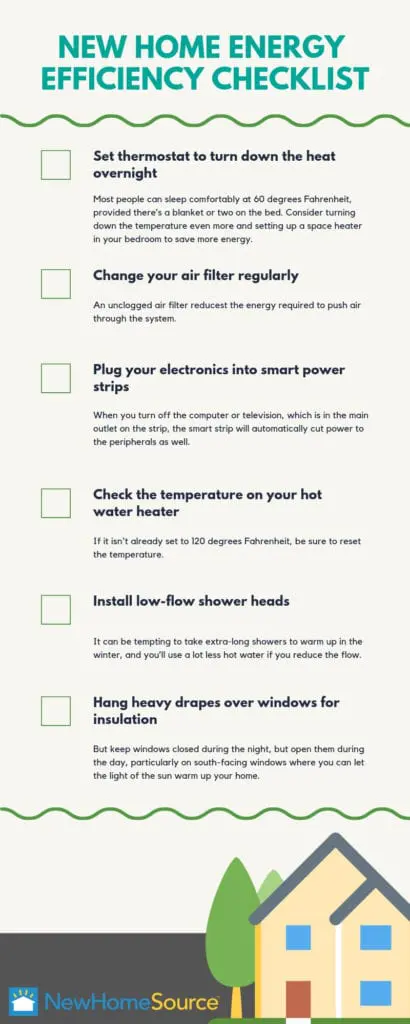Energy efficiency makes buying a new construction home instead of an old house a no brainer. Green features like Energy STAR appliances, a tight envelope, and sustainable materials often come standard in new homes, reducing utility bills and the amount of energy needed to maintain a comfortable home.
Conserving energy, and reducing your utility bill, is important. NewHomeSource has an energy efficiency checklist with quick and easy tips to make your new home, and your lifestyle greener.
Home Energy Efficiency Checklist
Complete each of these tasks this month to prepare your home for maximum energy efficiency:
- Set your programmable thermostat to turn down the heat overnight. Most people can sleep comfortably at a temperature of 60 degrees Fahrenheit, provided there’s a heavy blanket or two on the bed. If it’s only you in the house, consider turning down the temperature even more and setting up a space heater in your bedroom to save more energy.
- Change your air filter on the furnace blower to reduce the energy required to push air through the system.
- Plug your computer and television and their peripherals into smart power strips. When you turn off the computer or television, which is in the main outlet on the strip, the smart strip will automatically cut power to the peripherals as well. This is especially helpful during the winter, when you will presumably be spending more time indoors using these devices.
- Check the temperature on your hot water heater, and turn it to 120 degrees Fahrenheit if it isn’t already.
- Install low-flow showerheads in all of your showers if they don’t already have them. It can be tempting to take extra-long showers to warm up in the winter, and you’ll use a lot less hot water if you reduce the flow.
- Hang heavy drapes on your windows for insulation. Keep them closed during the night, but open them during the day, particularly on south-facing windows where you can let the light of the sun warm up your home.
Rallying Your New Home Community
Multiply your efforts toward energy efficiency by encouraging your neighbors to do the same:
- Explain to a neighbor what you’re doing to save energy, and you may be surprised to learn it can have a real impact on the neighbor’s energy use as well.
- Consider more formal initiatives. Discuss energy with your community improvement board, and ask about making a presentation at the next community meeting.
- Supply handouts to your neighbors with practical tips on how they can practice energy efficiency.
- You can even discuss installing solar panels or a wind turbine in or around your community to generate clean energy.
Ways to Reduce Energy Consumption
You can break down home energy consumption into several categories that cover most of your energy use:
- Heating and cooling systems: Dress for the weather, and only heat or cool to a comfortable temperature. Use a programmable thermostat to reduce your energy use overnight and when you’re out of the house.
- Major appliances: Only run these when they are full, and choose the most energy-efficient settings. This includes washing clothes in cold water and letting dishes air dry rather than using a heated drying cycle.
- Electronics: Many electronics continue to draw power even when turned off, so be sure to unplug them when they’re not in use. Choose energy-efficient electronics when possible.
- Water heater: Choose a properly sized water heater for your household’s water use, and set it to a temperature of 120 degrees Fahrenheit. You may be able to get by with an even lower temperature during the summer. Install insulation around the water heater to reduce heat loss.
- Lighting: Install compact fluorescent bulbs, which use approximately 75 percent less energy than traditional incandescent bulbs. Turn off lights when you leave rooms, and open windows during the day to take advantage of sunlight rather than turning on electric lights.

